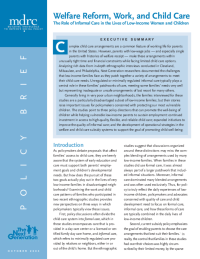Welfare Reform, Work, and Child Care
The Role of Informal Care in the Lives of Low-Income Women and Children
As policymakers debate proposals that affect families’ access to child care, they are keenly aware that the system of early education and care must support both parents’ employment goals and children’s developmental needs. But how does the pursuit of these two goals actually play out in the lives of very low-income families in disadvantaged neighborhoods? Examining the work and child care patterns of families who participated in two recent ethnographic studies provides new perspectives on three ways in which policymakers typically view these issues.
First, policy discussions often divide the child care system into formal care, which in these studies encompasses care that is provided in a day care center or a licensed or certified family day care home, and informal care, which refers to minimally regulated care provided by relatives or neighbors, either in or out of the child’s home. But the ethnographic studies suggest that discussions organized around these distinctions may miss the complex blending of arrangements used by many low-income families. When families in these studies did use formal care, it was almost always part of a larger patchwork that included informal situations. Moreover, informal care dominated many blended arrangements and was often used exclusively. Thus, for policy to truly reflect the daily experiences of low-income children, policymakers and advocates concerned with quality of care and child development need to focus on formal care, informal care, and how these forms of care are typically combined in the daily lives of low-income children.
Second, current subsidy policy emphasizes the goal of enabling parents to choose the care arrangements that best suit their families. In reality, the control that families in these studies had over their choices was highly circumscribed by their limited money, by the sparse care options of their low-resource neighborhoods, and by the inflexibility of their role as employees. Parents ranked their children’s well-being as their top priority, and many said they would leave jobs if their children were ever placed at risk. Nevertheless, they rarely were seen taking this step unless their child care arrangements collapsed completely. Instead, they often resigned themselves to leaving their children in situations they knew were far from ideal.
Third, the ethnographic interviews highlight a hidden but significant cost of care for low-income single parents — the enormous logistical effort required to keep arrangements intact. This level of effort may, in fact, both conflict with the requirements of parents’ jobs and reduce the amount of attention parents can devote to their children. Moreover, it may prevent parents from applying for and utilizing child care subsidies, because, even though the cost of child care was a primary concern, seeking and maintaining subsidies often seemed to require considerable time and effort.
To further describe the realities the studies document for these families, this policy brief considers three issues in greater detail: why parents resorted to patchwork and informal care; parents’ experiences with subsidies; and the extent to which their arrangements met minimal standards of health, safety, and predictability.






